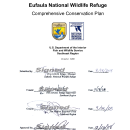Management and Conservation
Longleaf restoration/prescribed burning
Eufaula National Wildlife Refuge lies within the historical range of the longleaf pine/wiregrass ecosystem and contains remnant longleaf pine stands. Longtime residents tell of open, grassy understories and quail hunting in the longleaf forests. Gopher tortoises, indigo snakes, and red-cockaded woodpeckers are a few wildlife species associated with the longleaf/wiregrass ecosystem. Longleaf pines have poor natural regeneration due to crowding by loblolly pines, so restoration efforts are underway. Restoration involves planting longleaf seedlings and conducting prescribed burns periodically. Longleaf pines in various stages can be seen around the refuge as restoration efforts continue.
Agricultural/seasonal wetland management
The 300 acres of agricultural fields are planted each year in corn, wheat, soybeans, sunflowers, or grain sorghum for wildlife needs. Wildlife species likely to be seen in the fields in summer include deer, turkey, raccoons, armadillos, hawks, bluebirds, and other songbirds. Ducks, geese, and sandhill cranes
Nonnative and invasive plant control
Exotic and invasive species invasive species
An invasive species is any plant or animal that has spread or been introduced into a new area where they are, or could, cause harm to the environment, economy, or human, animal, or plant health. Their unwelcome presence can destroy ecosystems and cost millions of dollars.
Learn more about invasive species are the most serious threat to the conservation of natural resources at Eufaula National Wildlife Refuge. Native invasive and weedy upland plants including sicklepod, cocklebur, mourning glory, and sesbania are problems in agricultural fields and impoundments. Exotic species including Chinese privet, Chinaberry, and Japanese honeysuckle are pervasive along forest edges. Hydrilla, water hyacinth, alligatorweed, American lotus, and other aquatic plants hinder management of aquatic resources. The refuge manages invasive and exotic plants by mechanical, biological, and chemical methods. Visitors may see evidence of feral hogs rooting in the agricultural fields and along the roadways. Trapping is the primary control method for hogs on the refuge.
Trapping Occurs on this Refuge.
Trapping is a wildlife management tool used on some national wildlife refuges. Trapping may be used to protect endangered and threatened species or migratory birds or to control certain wildlife populations. The U.S. Fish and Wildlife Service also views trapping as a legitimate recreational and economic activity when there are harvestable surpluses of fur-bearing mammals. Outside of Alaska, refuges that permit trapping as a recreational use may require trappers to obtain a refuge special use permit. Signs are posted on refuges where trapping occurs. Contact the refuge manager for specific regulations. Click here for more information on trapping within the National Wildlife Refuge System.
Prescribed Fire

